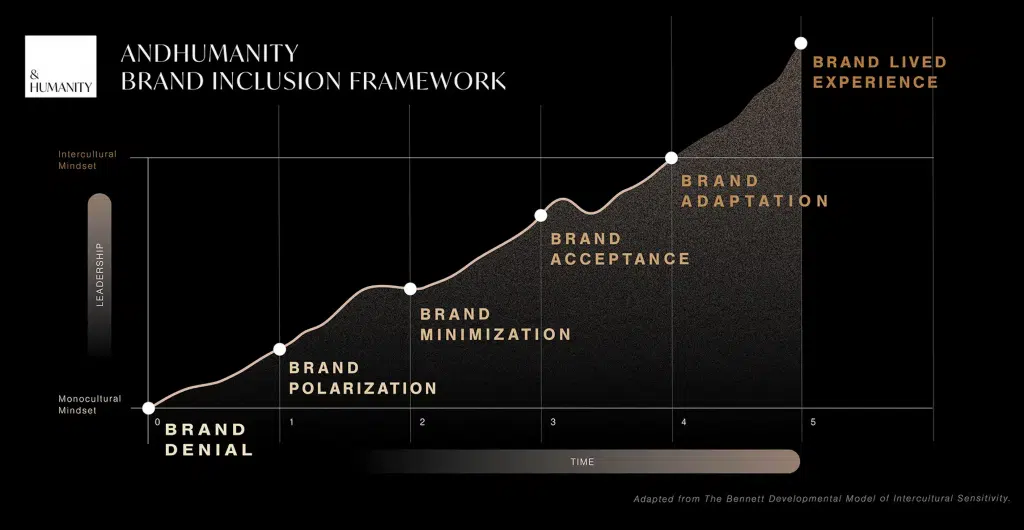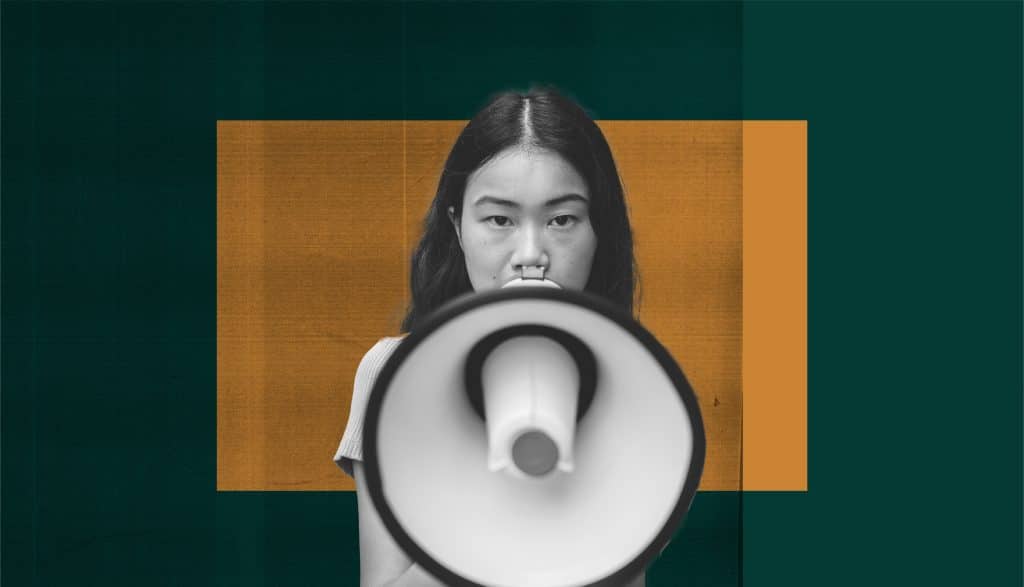It’s been over 4 years since we introduced and shared the origin story behind our Brand Inclusion Framework in this article. Today, we share an updated version of the framework after many years of growth and learning.
Inclusion work is ongoing, iterative, and ever-evolving.
Committing to and actioning inclusion requires awareness and an acceptance that this work, being inclusive, is forever unfinished. That said, there is a level of homeostasis we can each aim to reach whereby the work becomes more about sustaining inclusion versus reaching it — Adaptation.
Adopting a framework for inclusion
AndHumanity developed the Brand Inclusion Framework and Inclusion Continuum as an assessment and reflexivity tool to help guide organizations in better understanding where their brand might be in its inclusion journey. In addition, the AndHumanity Brand Inclusion Framework and Inclusion Continuum helps brands to take authentic and sincere steps toward inclusion. The framework is informed by the developmental model of intercultural sensitivity (the Bennett Scale) and is specifically designed with organizations and brands in mind.
The Inclusion Continuum can be used to assess individual campaigns, general marketing and communications, and overall brand placement. It’s important to remember that a brand’s perceived placement on the Continuum is not a moral judgment and does not indicate willingness to change. Rather, placement provides critical insights to support opportunity-based actions that increase a brand’s inclusive strengths.
But, what does inclusion look like?
Firstly, there’s no one way to be inclusive. Inclusion is human-centred which means what feels and looks inclusive will be different for different people and will change over time. This is why authentic inclusion necessitates lived experience, nothing about us without us.
At AndHumanity we define inclusion as an active, intentional, and continuous process to address inequities in power and privilege and build a respectful and diverse community that ensures welcoming spaces and opportunities to flourish for all. It requires deliberate and intentional action.
Inclusion isn’t about including everyone, it’s about being intentional and aware of who is being excluded and included.
Understanding the states of inclusion.
The Inclusion Continuum is made up of five (5) states; starting with Denial, the Continuum moves through Polarization, Minimization and Acceptance to end at Adaptation.

- Brand Denial is when we ignore or negatively impact diverse audiences and assume the dominant group or perspective is superior.
- Brand Polarization is when we are starting to recognize and maybe even slightly engage with diversity, but remain resistant to embracing it.
- Brand Minimization is when we begin to embrace diversity but focus on universal experiences or the aspects of diversity that are most palatable for the dominant culture.
- Brand Acceptance is when we are starting to recognize the unique challenges and needs of different groups and have begun to incorporate these considerations into our practices.
- Brand Adaptation is when we fully recognize the unique challenges and needs of different groups, including the nuances and intersectionalities within, and fully incorporate this into our operations.
Brand Lived Experience
Key Characteristic: built with diversity and inclusion
| Brand Lived Experience | We are founded with lived experience. Diversity and inclusion are built into the organization’s foundations and embedded in our origin story. (Built with diversity and inclusion) |
Brand Lived Experience identifies brands that were founded with diversity and inclusion built in. The outcomes may look identical to a brand in adaptation, the furthest position on the Inclusive Continuum, however, an important distinction is that these characteristics weren’t learned or developed. They’re key elements of the brand’s history and identity.
An example of Brand Lived Experience includes the brands Fenty Beauty (inclusive make-up brand) and Savage X Fenty (inclusive lingerie brand) both founded by Rihanna.
A brand with built-in diversity and inclusion can still enter the Continuum at different states for different communities, outputs and processes. Whilst lived experience can be built into a brand, the brand is not then automatically wholly representative of every community and experience.
Denial
Key Characteristic: rigid
| Denial | We completely ignore or negatively impact diverse audiences, assuming the dominant group or perspective is superior(Rigid) |
In denial, a brand is ignoring or negatively impacting audiences (whether intentionally or unintentionally) and assumes a lens in which the dominant group is presumed superior. In this stage, the brand struggles to conceptualize ways to engage in diverse efforts and inclusive understandings.
Polarization
Key Characteristic: resistance and defense
| Polarization | We are starting to recognize, and maybe even slightly engage with, diversity, but remain resistant to it (Resistance and Defense) |
In polarization, a brand is moving from awareness to understanding. The brand may be set in its current ways. Polarization is an ethnocentric placement, meaning that all other cultures or dimensions of difference are compared to the dominant one. While unintentional, there is often an implication that equity-deserving audiences are different from or less than the dominant culture. Often, in this stage, brands are being called out, their audiences are asking for more inclusion, or they recognize a need to and are seeking to change, but they may not see how change is possible or be resistant to change.
Minimization
Key Characteristic: desire and fear
| Minimization | We are beginning to embrace diversity, but focus on universal experiences or the aspects of diversity that are most palatable for the dominant culture. (Desire and Fear) |
In minimization, a brand recognizes that there is diversity in its audiences but is early in its inclusion journey and focuses on similarities and a sense of unity. Minimization is still an ethnocentric placement and can feel superficial or fall into stereotypes and generalizations. However, minimization can also be actioned in ways that feel inclusive as brands progress through the framework.
Acceptance
Key Characteristic: commitment and action
| Acceptance | We are starting to recognize the unique challenges and needs of different groups and have begun to incorporate these considerations into our practices. (Commitment and Action) |
In acceptance, a brand recognizes they have a diverse audience with different needs and communication styles. They begin to understand the need to be able to speak beyond a dominant lens in a way that authentically recognizes difference. There is a move towards deep storytelling (telling authentic, nuanced, and intersectional stories) with specific equity-deserving people and communities, rather than focusing on generalized diversity. Inclusion starts to be integrated into a brand’s main campaign and marketing efforts, rather than as a side campaign or afterthought. At this stage, brands also have a standard level of inclusive design.
Adaptation
Key Characteristic: competence and comfort
| Adaptation | We fully recognize the unique challenges and needs of different groups, including the nuances and intersectionalities within, and fully incorporate these into our operations. (Competence and Comfort) |
In acceptance, a brand is authentically inclusive through committed and sustained growth. Adaptive brands are leaders in Inclusive Marketing. They can navigate between, and authentically include, different cultural norms to deeply resonate with those who have lived experience. They truly understand the challenges and needs of the equity-deserving people and groups they’re representing and engaging with. Their organizational values and actions align with their messaging. In adaptation, brands often advocate for and support the community through their marketing efforts to break down barriers.
Key Takeaways
- The Continuum is made up of five (5) states: Denial, Polarization, Minimization, Acceptance and Adaptation.
- The Inclusion Continuum can be used to assess individual campaigns, general marketing and communications, and overall brand placement.
- You may be in different states with different communities and or dimensions of identity (Ex. Perceived as accepting of straight, cisgender People of Colour and in denial of 2SLGBTQIA+ people).
- Similarly, outputs and processes can range from completely non-inclusive to completely inclusive. Inclusion isn’t a binary.
Where to next?
We’ve covered a lot of terminology and definitions in this post, to better understand the Continuum we recommend starting by reflecting on the terms “diversity” and “inclusion” because these two terms can often get conflated.
- Diversity is about the what – it focuses on the makeup of a group, the range of human difference. Whereas Inclusion is about the how – the creation of an environment and culture that provides welcome and enables each individual to thrive.
How are diversity and inclusion showing up in your spaces?
For a more detailed breakdown of each stage in the continuum, utilize our self-serve Brand Assessment Tool (only takes ~5min) and you’ll receive an email linking to in-depth descriptions and examples pertaining to each stage.
This article was written by Ness Murby (he/him) a queer, trans, blind disabled person, Ness describes himself as human first. He is a Dad, Gran’s kid always and Pop’s ‘tiger’ forever. Australian, mixed race and white presenting, grateful to currently reside on Coast Salish Territory on the shared and unceded lands of many Indigenous Nations including the kʷikʷəƛ̓əm (Kwikwetlem), səlilwətaɬ (Tsleil-Waututh), xʷməθkʷəy̓əm (Musqueam), Sḵwx̱wú7mesh (Squamish), q̓ic̓əy̓ (Katzie), qʼʷa:n̓ ƛʼən̓ (Kwantlen), qiqéyt (Qayqayt), and Stó:lō (Sto:lo). Ness works as the Senior Justice, Equity, Diversity, and Inclusion Strategist at AndHumanity, is a counsellor and competes as a Canadian Paralympian. He is a lover of puzzles, connection and culture.








